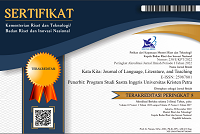MEANINGS IN THE PROCESS OF SIGNIFICATION OF LANCÔME’S BEAUTY SERUM ADVERTISEMENTS
DOI:
https://doi.org/10.9744/katakita.5.1.1-7Keywords:
Media Pembelajaran, Kecerdasan Emosional, Psikologi, Permainan VideoAbstract
Through this study, the writer aimed to find out how meanings are created in advertisements video. The three objectives of this study are to find out how meanings are created through verbal expressions, how the visual expressions of the advertisements support the verbal expressions and to find out the differences between the two advertisements. The data used to conduct this study were Lancôme Génifique Serum Advertisement (2009) and Lancôme Advanced Génifique Serum (2013). After analyzing the data with the research questions in mind, the writer found out that meanings in both advertisements are created through the verbal captions and what were visually shown on the advertisement videos. The writer also found out that there were a few differences between the first and second advertisements. The second advertisement provides more appealing visuals, more direct and convincing verbal expressions and more facts and needed information regarding the promoted product. These factors make the second advertisement an improved version of the first one.
References
Chandler, D. (2007). Semiotics The Basics (2nd ed). London: Routledge.
Da Vinci Human Anatomy (n.d.) (2013). Retrieved November 22 2016 from http://humanbodyanatomy.us/da-vinci-human-anatomy/
Human Genetics Structure (n.d.) (2010). Retrieved November 11 2016 from http://scitechdaily.com/study-shows-four-stranded-quadruple-helix-dna-structure-in-human-cells/
Port, R. Linguistics (2000). Retrieved November 15 2016 from http://www.cs.indiana.edu/~port/teach/103/sign.symbol.html
Saussure,F. (1974). Course in General Linguistics. London: Fontana
Storey, J. (2009). Cultural Theory and Popular Culture : An Introduction (5th ed).
What is Metabolism? (n.d.) (2009) Retrieved November 22 2016 from http://www.news-medical.net/life-sciences/What-is-Metabolism.aspx
Downloads
Issue
Section
License
Authors who publish with this journal agree to the following terms:- Authors retain copyright and grant the journal right of first publication with the work simultaneously licensed under a Creative Commons Attribution License that allows others to share the work with an acknowledgement of the work's authorship and initial publication in this journal.
- Authors are able to enter into separate, additional contractual arrangements for the non-exclusive distribution of the journal's published version of the work (e.g., post it to an institutional repository or publish it in a book), with an acknowledgement of its initial publication in this journal.
- Authors are permitted and encouraged to post their work online (e.g., in institutional repositories or on their website) prior to and during the submission process, as it can lead to productive exchanges, as well as earlier and greater citation of published work (See The Effect of Open Access).














